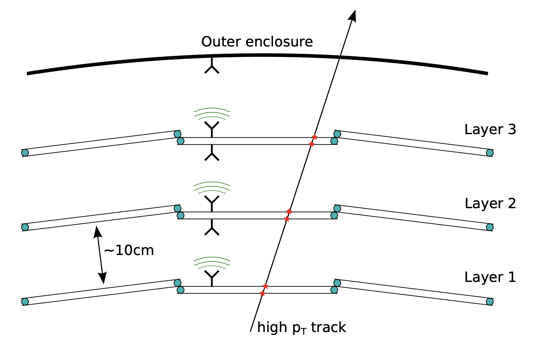By Antoine Le Gall (CERN), with support of Dragos Dancila (UU), project spokesperson.
Financed under AIDAinnova’s Blue-Sky programme, the WADAPT project will explore the use of wireless readout to transfer data in detectors.
To propagate the data following a collision, detectors use long cables going along the beam direction. Unfortunately, the material of the cables can degrade the precision of the measurement (scattering, nuclear interactions), impact the installation and suffer important latencies (axial readout). The WADAPT project proposes the use of wireless readout to transfer data. Wireless offers an elegant and cheaper option to cables. It allows ultra-low latency, direct communication between layers, radial readout and more flexibility in the transceiver placement.
Financed under AIDAinnova’s dedicated work package on prospective and technology-driven detector R&D (WP13 - Blue-Sky programme), WADAPT – which stands for Wireless for Data and Power Transmission – is coordinated by the Uppsala University, a new participant to AIDAinnova, together with the Gangneung–Wonju National University (GWNU) in South Korea. This Blue-Sky project has been formed to study Multi-Gigabit Wireless Data Transfer for High-Energy Physics applications as following an initiative promoted by CERN (LoI, CERN-LHCC-2017-002;LHCC-I-028. – 2017).

Sketch of wireless data transfer in a three-layer detector.
At millimetre waves, very large bandwidths are available: 9GHz at 60GHz and 30GHz at 140GHz, respectively making possible very fast signal transfer and a radial readout. An efficient detector partitioning in topological regions of interest would provide elegant answers to complex topologies for fast triggering and even for physics requiring “trigger-less” data, such as low-mass processes, exotic Higgs decays, long-lived charged particles detection.
For vertex detectors at future colliders, such as FCC, the 60GHz band is adequate to transfer large amount of data in both directions in real-time with minimum latency to a large number of individual devices, which otherwise will be unpractical by using wire or optical connections, requiring to follow the construction. Commercial products are already available and have been tested for signal confinement, crosstalk, electromagnetic immunity, radiation hardness (up to 1014 Neq/cm2).
In its first phase, the project aims at exploring the possibility of using future state-of-the art solutions to meet the exceptionally high data transfer rates required by real-time acquisition in the most harsh and challenging environment in the world for wireless applications as readout of the data collected by the future FCC-hh collider. Although the FCC-ee does not introduce stringent requirements on the trigger capabilities, the experiments would certainly benefit from low material budget of the wireless technology.
System-in-package or system-on-board integration of millimetre wave transceivers and antennas for dense wireless links will be studied and a prototype as a proof of concept will be built. As a proof of concept, a three- till four-layer silicon detector mock-up will be built for demonstration in the project. This mock-up of a central tracker will be equipped with commercially available transceiver/receiver chipsets in a BGA package. Additionally, the data flow of the communication modules will gradually be increased from the 1 Gbps available today to 4 Gbps that would be needed at the end. In addition, the project will allow to study the added noise and data transmission quality over the different layers; it will also allow to study the antenna specifications: gain, polarization, bandwidth and radiation robustness. This might also lead to a conformal and flexible design of the antenna or antenna array structure.
While keeping in mind all of the constraints linked to a HEP use case, the first focus will be on the wireless link performance. The transceiver/receiver design may be adapted to consider the severe irradiation and magnetic field environment. After the proof of principle, there would be no obstacles to generalize the use of wireless readout to other detectors, with the potential of adding on-detector intelligence to perform 4-dimensional tracking on line.
